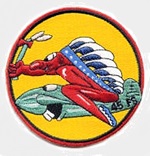ate Hobby Master HA5511 USAAF Curtiss P-40N Warhawk Fighter - Lieutenant Bruce Campbell, "Geronimo", 45th Fighter Squadron "Hoosier Hogs", Central Pacific, December 1943 (1:72 Scale)
"Flying is hours and hours of boredom sprinkled with a few seconds of sheer terror."
- Greg "Pappy" Boyington
 The P-40 was the best known Curtiss-Wright designed airplane of the Second World War. It was also one of the most controversial fighters, vilified by many as being too slow, lacking in maneuverability, having too low a climbing rate, and being largely obsolescent by contemporary standards even before it went into production. The inadequacies of the P-40 were even the subject of a Congressional investigation after the War ended.
The P-40 was the best known Curtiss-Wright designed airplane of the Second World War. It was also one of the most controversial fighters, vilified by many as being too slow, lacking in maneuverability, having too low a climbing rate, and being largely obsolescent by contemporary standards even before it went into production. The inadequacies of the P-40 were even the subject of a Congressional investigation after the War ended.
While these criticisms were certainly valid, it is also true that the P-40 served its country well, especially in China and Burma, during the opening phase of the War in the Pacific when little else was available to the US Army Air Corps. Along with the P-39 Airacobra, the P-40 was the only American fighter available in quantity to confront the Japanese advance until more modern aircraft could be delivered to frontline squadrons.
The P-40N (manufactured from 1943-44) represented the final production model of the P-40. The P-40N featured a stretched rear fuselage to counter the torque of the more powerful, late-war Allison engine, and the rear deck of the cockpit behind the pilot was cut down at a moderate slant to improve rearward visibility. A great deal of work was also done to try and eliminate excess weight to improve the Warhawk's climb rate. Early N production blocks dropped a .50 in (12.7 mm) gun from each wing, bringing the total back to four; later production blocks reintroduced it after complaints from units in the field. Supplied to Commonwealth air forces as the Kittyhawk Mk IV. A total of 553 P-40Ns were acquired by the Royal Australian Air Force, making it the variant most commonly used by the RAAF. Subvariants of the P-40N ranged widely in specialization from stripped down four-gun "hot rods" that could reach the highest top speeds of any production variant of the P-40 (up to 380 mph), to overweight types with all the extras intended for fighter-bombing or even training missions. The 15,000th P-40 was an N model decorated with the markings of 28 nations that had employed any of Curtiss-Wright's various aircraft products, not just P-40s.
Pictured here is a 1:72 scale replica of a USAAF Curtiss P-40N Warhawk fighter that was piloted by Lieutenant Bruce Campbell and nicknamed "Geronimo" who was attached to the 45th Fighter Squadron "Hoosier Hogs", then deployed to the Central Pacific during December 1943.
Pre-order! Ship Date: Late December 2024.
Dimensions:
Wingspan: 6-inches
Length: 5-inches
Release Date: ?
 Historical Account: "Gone But Not Forgotten" - The 45th was sent to the Central Pacific in 1943 for combat operations against Japanese forces. Then, on April 6th, 1944, the squadron returned to Mokuleia Field, Hawaii, and began training for very-long-range (VLR) bomber escort missions. By this time, the pilots in the squadron were flying Republic P-47 Thunderbolts. Later in the year they would acquire the longer range North American P-51 Mustangs.
Historical Account: "Gone But Not Forgotten" - The 45th was sent to the Central Pacific in 1943 for combat operations against Japanese forces. Then, on April 6th, 1944, the squadron returned to Mokuleia Field, Hawaii, and began training for very-long-range (VLR) bomber escort missions. By this time, the pilots in the squadron were flying Republic P-47 Thunderbolts. Later in the year they would acquire the longer range North American P-51 Mustangs.
In January 1945, the 45th was ordered into combat, along with the other assigned squadrons in the 15th group. It left Hawaii for Saipan in the Marianas Islands, staying there until the Marines on Iwo Jima could secure a landing strip.
The first squadron to arrive at Iwo Jima was the 47th Fighter Squadron on the morning of March 6th, with the 45th landing the next day. They supported Marine ground units by bombing and strafing cave entrances, trenches, troop concentrations, and storage areas. Before the month was over, the 45th began strikes against enemy airfields, shipping and military installations in the Bonin Islands.
Flying its first VLR mission to Japan on April 7th, 1945, the 45th provided fighter escort for the Boeing B-29 Superfortresses that attacked the Nakajima aircraft plant near Tokyo. In late April and early May that year, the 45th struck airfields on the Japanese home island of Kyushu to hold back the enemy's Kamikaze attacks against the American invasion force on Okinawa. The squadron also attacked enemy troop trains, small factories, gun positions, and hangars in the Bonin Islands and Japan.
During the summer of 1945, the 45th was assigned to the Twentieth Air Force and continued its fighter sweeps against Japanese airfields and other tactical targets. It continued to fly long-range B-29 escort missions to Japanese cities until the end of the war. After the Japanese surrender, the squadron remained on Iwo Jima until November 25th, 1945, when it transferred to Bellows Field, Hawaii. On February 8th, 1946, the squadron moved to Wheeler Field, where it stayed until inactivated on October 15th, 1946.


